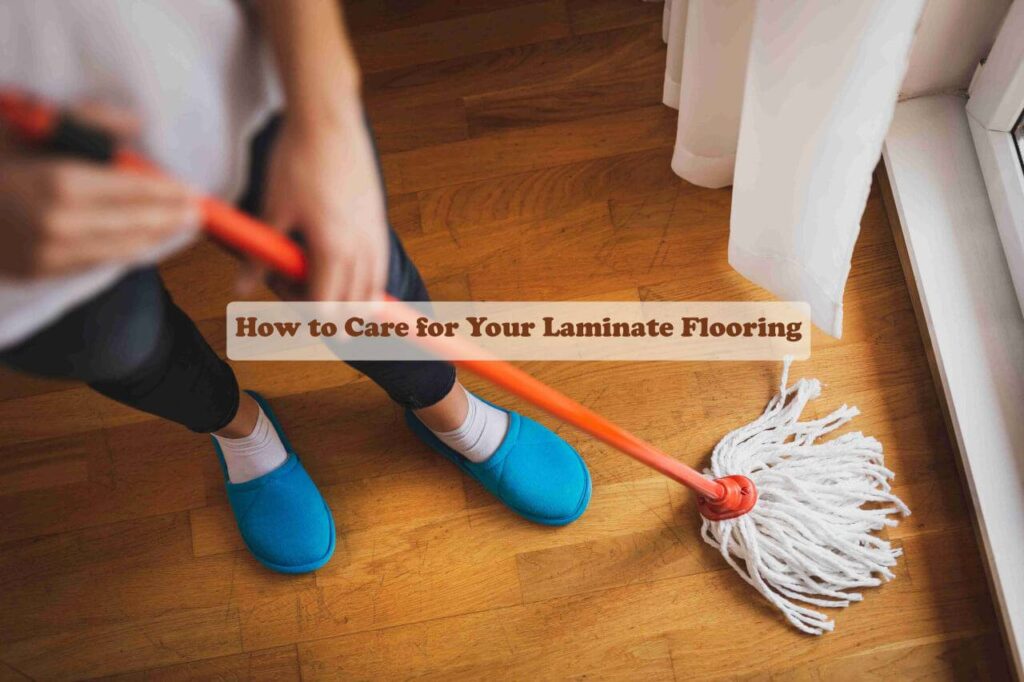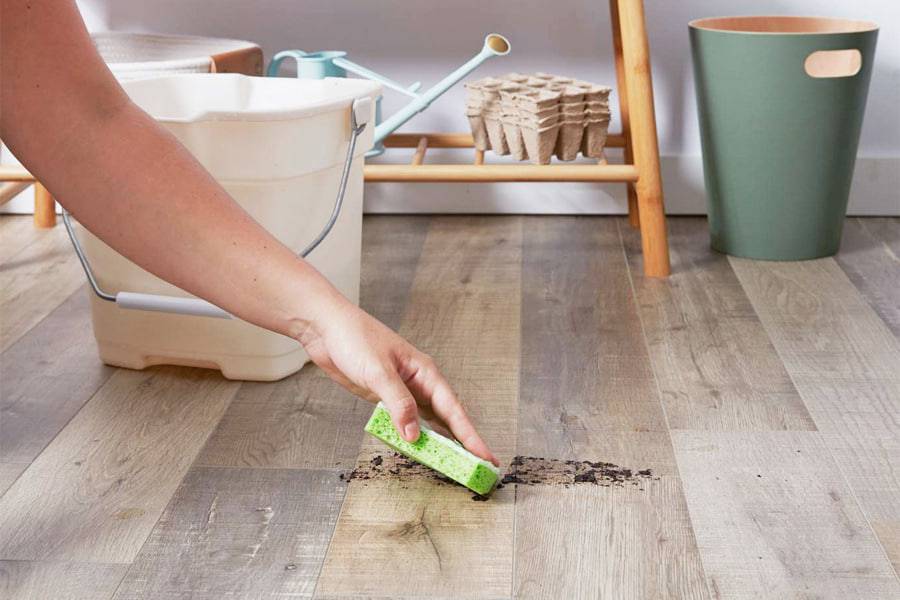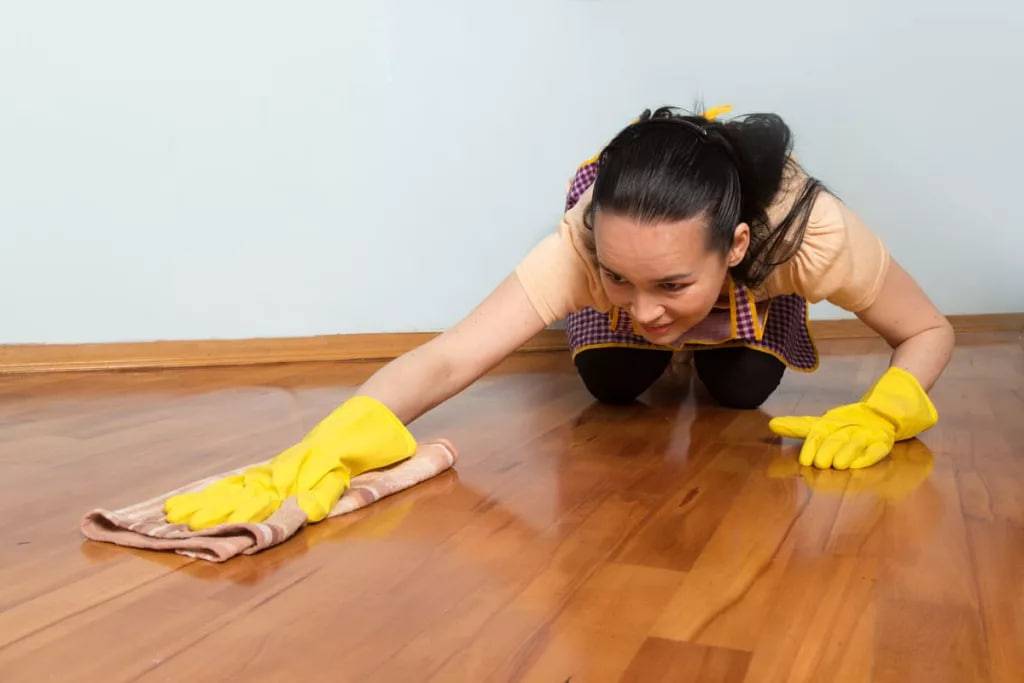Laminate flooring has become a popular choice for its style and durability. But to keep it looking its best and lasting for years, proper care is essential. This guide will show you how to easily maintain your laminate floors at home, ensuring they continue to impress with their beauty and functionality.
While checking your laminate’s manufacturer’s instructions is always a good first step, keeping it clean is often quite simple. Luckily, you won’t need a lot of fancy equipment. A soft broom or microfiber mop is all you really need for regular cleaning. Plus, we’ll explore some other easy tips to keep your floors sparkling in the next section!
Want beautiful, durable laminate flooring that lasts? Dex Flooring offers a wide variety of high-quality laminate flooring options, including scratch-resistant and water-resistant selections. Visit our website or showroom today to find the perfect laminate floor for your home!
How do you clean laminate floors?
Laminate flooring might look tough, but it’s important to remember it’s not waterproof. Harsh chemicals and abrasive cleaners can damage the surface. Skip the all-purpose cleaners, dish soap, and anything with wax.
Instead, opt for gentle cleaning solutions. Here are your best bets:
- Manufacturer-recommended cleaner: Always check your laminate’s manufacturer’s instructions first. They might have a specific cleaning solution they recommend for optimal results.
- DIY vinegar solution: A classic and effective choice! Mix one cup of white vinegar with a gallon of warm water in a spray bottle or bucket. This is a natural disinfectant and cuts through grime without harming the laminate.
- Microfiber mop: These are fantastic for laminate floors. They trap dirt and dust effectively without needing excessive moisture.
Prevention is Key: Keeping Dirt Out
The first line of defense for clean laminate floors is keeping dirt out in the first place. Here’s a simple trick:
- Doormats: Place doormats both outside and inside entryways. This helps trap dirt and debris before it gets tracked onto your laminate.
Mopping Magic: Keeping Your Floors Sparkling
Now that you have the right tools, let’s talk technique:
- Microfiber mop magic: Use your microfiber mop with your chosen cleaning solution. Remember, the key is damp, not soaking wet. Wring out the mop thoroughly so it’s just slightly damp to the touch.
- Less is more: Avoid over-wetting the floor. Excess water can seep into the seams and damage the laminate.
- One-direction mopping: Mop in straight lines in one direction to avoid spreading dirt around.
- Dry it up: After mopping, use a clean, dry microfiber cloth to buff the floor and remove any remaining moisture. This will help prevent water spots and streaks.
Conquering Spills and Everyday Dirt: Quick Action is Key
Laminate floors are beautiful, but they require a quick response to spills. Here’s how to be a spill-fighting pro:
- Act fast: The quicker you address a spill, the less likely it is to stain or damage the floor. Blot up any excess liquid with a clean, absorbent cloth like a microfiber towel. Don’t rub, as this can spread the spill further.
- Damp cloth, not a wet mop: For any remaining residue, use a slightly damp microfiber cloth. Remember, our mantra is “damp, not dripping” to avoid water seeping into the laminate.
- Dry it completely: After cleaning the spill, use a dry microfiber cloth to buff the area and remove any leftover moisture. This prevents water spots and keeps your floor sparkling.
Keeping Up with Daily Dirt:
Routine cleaning is essential to maintain the beauty of your laminate floors. Here’s how to stay ahead of the dust bunnies:
- Sweeping or vacuuming: Regularly sweep with a soft-broom or vacuum with the hard floor attachment to remove loose dirt and dust. This helps prevent scratches and keeps your floors looking their best.
- Dry microfiber magic: For everyday dust pick-up, use a dry microfiber mop or cloth. Microfibers trap dust effectively without needing any cleaning solutions.
Deep Cleaning for a Refresh
For a deeper clean, you can step up your routine a bit:
- Specialist cleaner: If your floors need a more intensive clean, opt for a specialist laminate floor cleaning solution. However, always ensure the mop is well-wrung and the floor isn’t left soaking wet.
- Beware of bevelled edges: If your laminate flooring has beveled edges or V-grooves, be cautious with mopping. Excessive moisture can trap dirt in the grooves, making it harder to clean later. Consider using a slightly damp microfiber cloth specifically for these areas.
- Tackling Sticky Situations: Life happens, and sometimes sticky substances like chewing gum or candle wax find their way onto your laminate floor. Here’s how to handle them:
- Ice to the rescue: Harden the sticky culprit with ice cubes in a plastic bag.
- Gently scrape: Once hardened, carefully scrape off the substance with a plastic scraper. Be sure to avoid using metal tools that could scratch the laminate.
- Wipe clean: Finally, wipe the area clean with a slightly damp microfiber cloth to remove any residue.
Conquering Food Stains
Laminate floors are susceptible to food stains, but don’t worry, they can be tackled! Here are some safe and effective methods:
- Start mild: Always try the gentlest method first. Mix a solution of warm water with a few drops of dish soap. Apply with a damp microfiber cloth and blot the stain. Rinse the cloth frequently and avoid oversaturating the floor.
- Vinegar power: If the stain persists, try a white vinegar solution. Mix equal parts white vinegar and water in a spray bottle. Lightly mist the affected area and blot with a clean microfiber cloth. Remember, never directly pour the vinegar solution onto the floor.
- For stubborn stains (use with caution): If the stain is still visible, you can consider a stronger solution, but use caution. Mix a very diluted ammonia solution (125ml ammonia to 5 liters of warm water). Test this solution in an inconspicuous area first to ensure it doesn’t discolor the laminate. If all is well, apply a small amount to the stain with a damp cloth, leave for a maximum of 10 minutes, and then scrub gently with a soft-bristled brush. Rinse thoroughly with clean water and dry completely.
Always remember: It’s better to start with milder methods and gradually progress to stronger solutions if needed. This minimizes the risk of damaging your laminate floor.
Eradicating Shoe Scuffs: Gentle Does It
Annoying shoe scuffs can appear on your laminate floor, but fear not! Here’s how to banish them with ease:
- The power of a damp cloth: Often, a simple solution is all you need. Start by wiping the scuff mark with a slightly damp microfiber cloth. The moisture can help lift the scuff mark.
- Rubber eraser magic: If a damp cloth doesn’t do the trick, a rubber eraser can be your next weapon. Choose a clean, white rubber eraser and gently rub along the grain of the wood. Avoid using plastic or gritty erasers as they can scratch the laminate surface.
- Scuff eraser reinforcements: For stubborn scuffs, head to your local hardware store. Look for specialist scuff erasers designed specifically for laminate flooring. These erasers are often very effective at removing tougher marks.
Remember: Always test any cleaning method on an inconspicuous area of your floor first to ensure it doesn’t cause discoloration.
Maintaining the Shine of Your Laminate Floors
Laminate floors are known for their beauty, but over time, dirt and dust can build up, making them appear dull. Here’s how to keep your floors sparkling and address any loss of shine:
- Regular Cleaning is Key: Sweeping or vacuuming with a hard floor attachment regularly removes loose dirt and prevents scratches.
- Beware of Gritty Enemies: Deal with stones or gravel promptly to avoid scratches on the laminate surface.
- The Power of Mop and Vinegar: For a deeper clean, use a well-wrung microfiber mop with a solution of water and vinegar. The vinegar helps restore shine naturally.
- Intensive Cleaning for Stubborn Dullness: If mopping doesn’t revive the shine, try a hands-on approach. Apply a water and vinegar solution to a slightly damp microfiber cloth and buff the floor in sections. Remember, “damp” is key to avoid damaging the laminate.
- When Age Takes its Toll: For older laminate floors, dullness might be due to wear and tear. Consider using a floor shiner or applying a few coats of floor polish specifically designed for laminate. Caution: After applying polish, your floor may become slippery, so exercise extra care when walking on it.
Remember: Always test any cleaning solutions on an inconspicuous area first to ensure they don’t damage your laminate floor.
Preventing Scratches: An Ounce of Prevention
Laminate floors are tough, but scratches can happen. The good news is there’s a lot you can do to prevent them:
- Defense is the best offense: Look for laminate flooring with a scratch-resistant wear layer. Manufacturer information should detail this.
- Skip the abrasive cleaners: Avoid scouring pads, harsh chemicals, and anything abrasive. These can damage the laminate’s surface.
- Shoes off at the door: Make it a habit to remove shoes at the door. This keeps dirt and small pebbles that can scratch the floor from getting tracked in. A doormat placed outside and inside entryways provides an extra layer of defense.
Dealing with Minor Scratches: Repair Options
If you do find minor scratches, there are solutions:
- Scratch filling kits: DIY shops stock laminate floor repair kits. These kits typically contain colored wax sticks or filling compounds that can be used to camouflage small scratches.
- Furniture touch-up markers: Sometimes, a simple furniture touch-up marker matching the color of your laminate can effectively hide minor scratches.
Remember: For deeper scratches or gouges, consulting a professional floor repair specialist is recommended.
FAQs for Laminate Floor Care:
Are luxury vinyl planks (LVP) easier to care for than laminate?
Both laminate and LVP are easy to care for, but LVP might have a slight edge. LVP is generally more water-resistant, making spills less of a concern. However, laminate has come a long way, and many laminate brands offer water-resistant options as well. The best choice depends on your specific needs and priorities.
Is steam cleaning safe for laminate floors?
Absolutely not! Steam cleaning can damage laminate flooring by warping the planks due to excess moisture. Stick to traditional mopping methods with a well-wrung mop.
Can I use essential oils in my cleaning solution for laminate floors?
While essential oils are natural, some can be quite potent and damage the laminate surface. It’s best to avoid them altogether. A simple vinegar and water solution is a safe and effective cleaning option.
Are there eco-friendly cleaning solutions for laminate floors?
Absolutely! The vinegar and water solution mentioned earlier is a great eco-friendly choice. You can also find eco-friendly laminate floor cleaners at most major retailers. Look for options that are biodegradable and free of harsh chemicals.
What are some popular trends in laminate flooring right now?
- Wide planks: Wider planks create a more luxurious and spacious look.
- Light and airy colors: Light-colored laminates make rooms feel brighter and more open, perfect for the minimalist trend.
- Wood-look finishes: Realistic wood-look finishes remain popular, offering the beauty of hardwood at a fraction of the cost.
- Textured finishes: Textured finishes add depth and visual interest to laminate flooring.
Source for this article: https://www.carpetright.co.uk/laminate/laminate-care-guide/




